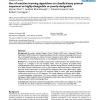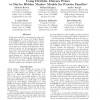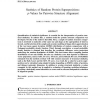383 search results - page 9 / 77 » Support Vector Training of Protein Alignment Models |
BMCBI
2008
13 years 7 months ago
2008
Background: By using a standard Support Vector Machine (SVM) with a Sequential Minimal Optimization (SMO) method of training, Na
ISMB
1993
13 years 8 months ago
1993
A Bayesian method for estimating the amino acid distributions in the states of a hidden Markov model (HMM) for a protein familyor the columns of a multiple alignment of that famil...
DMKD
2003
ACM
14 years 22 days ago
2003
ACM
Given a known protein sequence, predicting its secondary structure can help understand its three-dimensional (tertiary) structure, i.e., the folding. In this paper, we present an ...
BIOINFORMATICS
2005
13 years 7 months ago
2005
Motivation: Remote homology detection between protein sequences is a central problem in computational biology. Supervised learning algorithms based on support vector machines are ...
JCB
2008
13 years 7 months ago
2008
Quantification of statistical significance is essential for the interpretation of protein structural similarity. To address this, a random model for protein structure comparison w...



